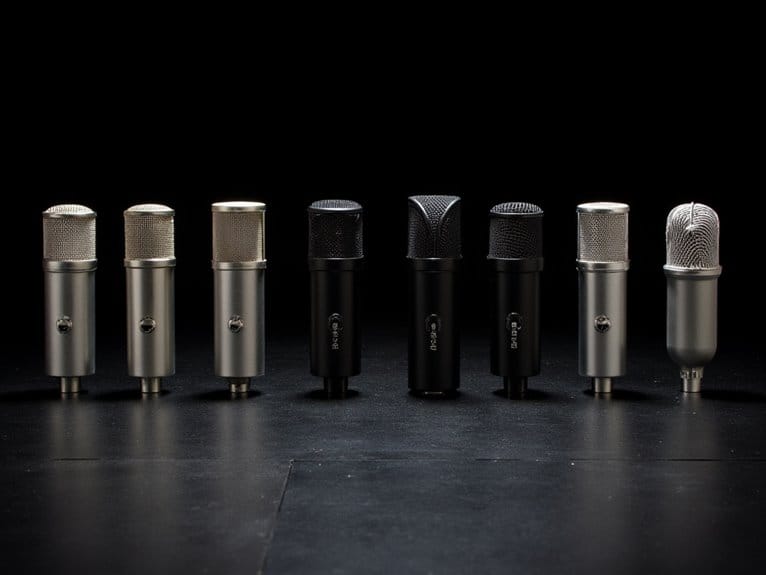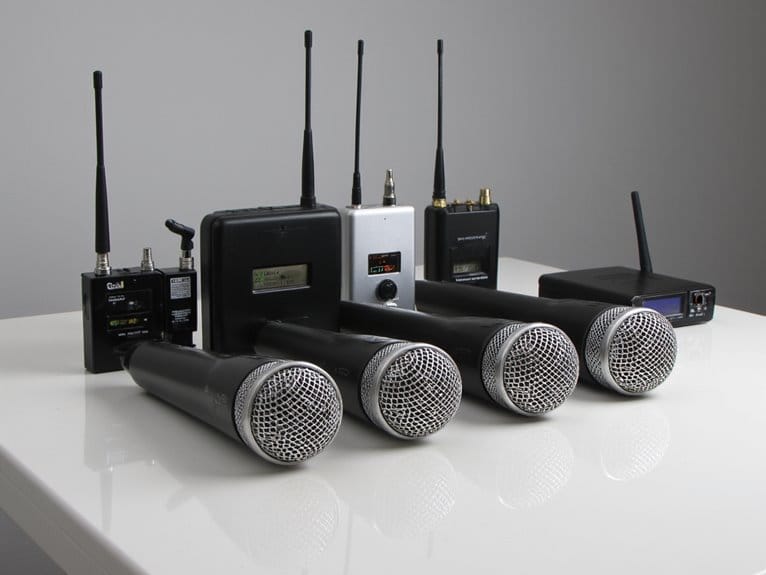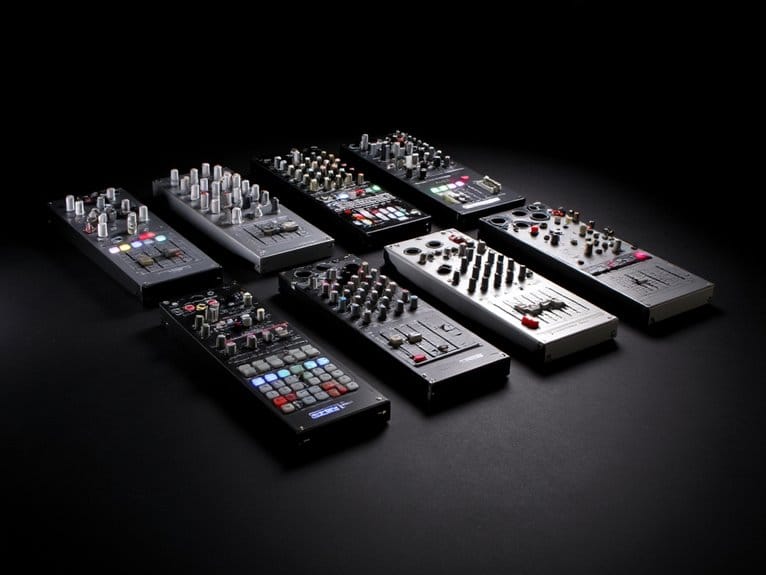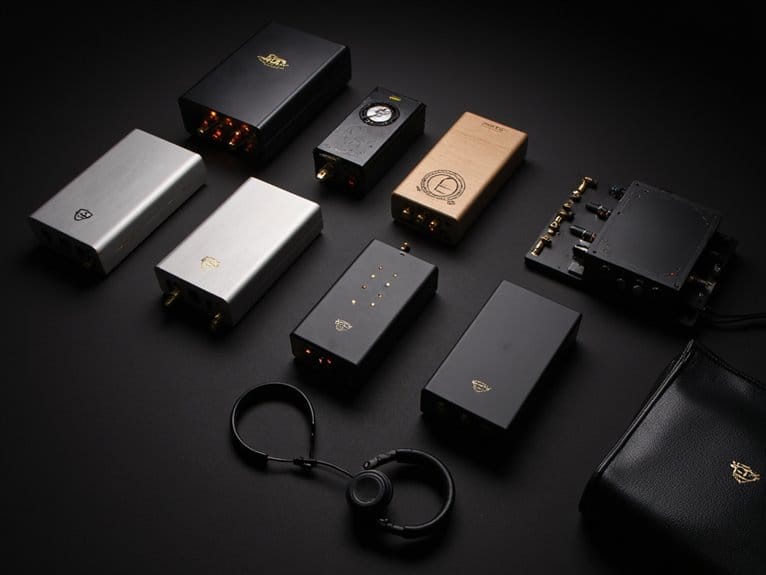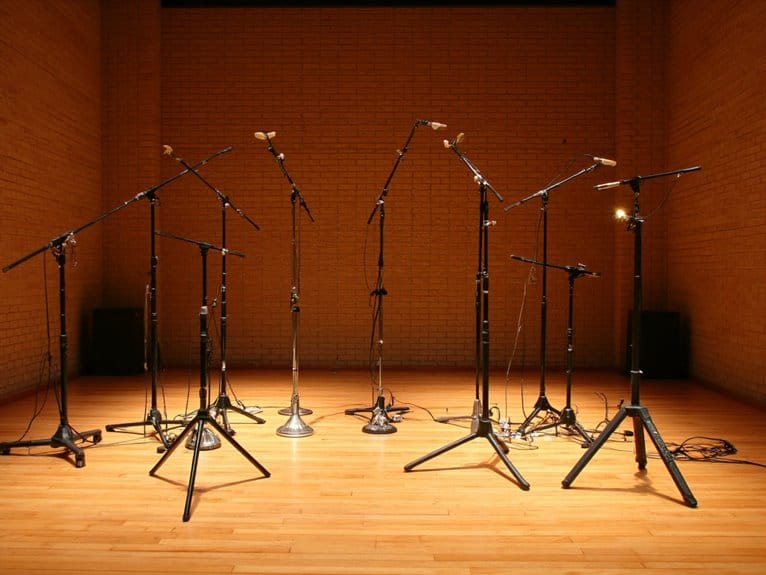10 Best Condenser Mics Under $200 for Professional-Quality Recording
After testing numerous budget condensers, I’ve found standout performers like the SENNHEISER MKE 200 with its 75 dB SNR and super-cardioid pattern, the versatile MAONO AU-A04 offering 192kHz/24-bit sampling with complete accessories, and the streaming-focused HyperX SoloCast featuring tap-to-mute functionality. The Behringer ECM8000’s transformerless circuitry delivers minimal distortion, while the MAONO PM320S provides XLR connectivity for budget-conscious creators seeking expandable setups, though phantom power requirements vary considerably across models and warrant careful consideration before purchase.
We are supported by our audience. When you purchase through links on our site, we may earn an affiliate commission, at no extra cost for you. Learn more.
Notable Insights
- Look for cardioid polar patterns and 20Hz-20kHz frequency response for balanced, professional sound capture with minimal background noise.
- Prioritize microphones with 75dB+ signal-to-noise ratio and 24-bit recording capabilities for crystal-clear, broadcast-quality audio output.
- Consider dual connectivity options (USB and XLR) to ensure compatibility with both computer setups and professional audio interfaces.
- Choose models with included accessories like pop filters, boom arms, and windscreens to minimize additional equipment costs.
- Verify phantom power requirements (15V-48V) match your audio interface capabilities before purchasing XLR condenser microphones.
SENNHEISER MKE 200 Condenser Microphone (508897)

If you’re a content creator, vlogger, or mobile videographer searching for professional-grade audio without breaking the bank, the SENNHEISER MKE 200 Condenser Microphone represents a compelling sweet spot between affordability and performance that’s hard to ignore. This super-cardioid directional microphone delivers impressive specs, including a 40 Hz to 20 kHz frequency range, 75 dB signal-to-noise ratio, and integrated wind protection that actually works in challenging outdoor conditions. You’ll appreciate the thoughtful design elements: internal suspension reduces handling noise, while interchangeable 3.5mm TRS and TRRS cables guarantee compatibility with both DSLR cameras and mobile devices without requiring additional adapters.
Best For: Content creators, vloggers, and mobile videographers who need professional-quality audio recording on a budget for both DSLR cameras and mobile devices.
Pros:
- Excellent value with professional specs including 40 Hz to 20 kHz frequency range and 75 dB signal-to-noise ratio
- Versatile connectivity with interchangeable TRS and TRRS cables for cameras and mobile devices
- Effective wind protection and internal suspension system that minimizes handling and environmental noise
Cons:
- Lacks detailed instructions which can be frustrating for beginners
- Occasional issues with low frequency performance noted by users
- May require additional adapters for some specific devices despite included cables
Behringer ECM8000 Ultra-Linear Omni-Directional Measurement Condenser Microphone

Audio engineers and acousticians who need precise room analysis without breaking the bank will find the Behringer ECM8000 Ultra-Linear Omni-Directional Measurement Condenser Microphone stands out as a specialized tool that prioritizes accuracy over traditional recording applications. You’ll appreciate its ultra-linear 20Hz-20kHz frequency response, which delivers the consistent measurement data that’s essential for acoustic analysis and room tuning applications. The omnidirectional polar pattern captures sound equally from all directions, making it ideal for working with real-time analyzers like Behringer’s ULTRACURVE DEQ2496 when you’re calibrating studio monitors or analyzing venue acoustics for best sound reproduction.
Best For: Audio engineers, acousticians, and sound professionals who need precise room analysis, acoustic measurement, and monitor calibration at an affordable price point.
Pros:
- Ultra-linear frequency response (20Hz-20kHz) provides highly accurate measurement data essential for acoustic analysis and room tuning
- Omnidirectional polar pattern captures sound equally from all directions, making it ideal for comprehensive room acoustics evaluation
- Exceptional value with transformerless FET input circuitry that minimizes distortion while maintaining professional measurement accuracy
Cons:
- Specialized measurement design may not perform as well as dedicated recording microphones for vocal or instrument capture
- Requires phantom power (+15V to +48V) which limits portability compared to dynamic microphones
- Omnidirectional pattern picks up ambient noise and room reflections that could be problematic in untreated acoustic environments
MAONO USB Microphone 192KHZ/24Bit PC Condenser Mic (AU-A04)

When you’re searching for a complete microphone package that won’t break the bank, the MAONO AU-A04 stands out as an exceptional choice for content creators, gamers, and podcasters who need professional-quality audio without the professional price tag. This cardioid condenser microphone delivers impressive 192kHz/24-bit sampling rates with a solid 70dB signal-to-noise ratio, ensuring your recordings maintain clarity across its 30Hz-16kHz frequency response range. What really sets this microphone apart is its extensive accessory package, including a sturdy boom arm, shock mount, pop filter, and foam windscreen-everything you’d typically purchase separately. The plug-and-play USB connectivity eliminates driver headaches, while the double-shielded cable reduces interference that can plague budget microphones.
Best For: Content creators, podcasters, gamers, and streamers who want professional-quality audio recording with a complete accessory package at an affordable price point.
Pros:
- Complete all-in-one package includes boom arm, shock mount, pop filter, and windscreen that would typically cost extra
- High-quality 192kHz/24-bit sampling with 70dB signal-to-noise ratio delivers professional audio performance
- True plug-and-play USB connectivity works across multiple platforms (PC, Mac, PS4/PS5) without requiring additional drivers
Cons:
- Some users report occasional connectivity issues and background noise concerns
- Requires OTG adapter for mobile phone compatibility, adding extra cost and complexity
- Limited frequency response range (30Hz-16kHz) compared to some higher-end condenser microphones
HyperX SoloCast USB Condenser Gaming Microphone

The HyperX SoloCast stands out as a gaming-focused powerhouse that delivers professional-grade audio quality through its cardioid polar pattern and 24-bit/96 kHz recording capabilities, making it the ideal choice for streamers, content creators, and gamers who need crystal-clear voice isolation without breaking the bank. You’ll appreciate its plug-and-play USB-C connectivity across PC, PS4, PS5, and Mac platforms, eliminating setup headaches that plague other microphones in this price range. The tap-to-mute sensor with LED indicator provides intuitive control during streaming sessions, while the adjustable stand fits seamlessly under monitors or attaches to standard boom arms via 3/8-inch and 5/8-inch threading.
Best For: Streamers, content creators, and gamers who need professional-quality audio recording with plug-and-play simplicity across multiple platforms without a premium price tag.
Pros:
- Excellent audio quality with 24-bit/96 kHz recording, cardioid polar pattern for voice isolation, and impressive 95 dB signal-to-noise ratio
- True plug-and-play functionality with USB-C connectivity across PC, PS4, PS5, and Mac with no driver installation required
- Versatile mounting options with adjustable stand and standard threading compatibility for boom arms, plus convenient tap-to-mute with LED indicator
Cons:
- Some compatibility issues reported with Windows 11 requiring manual driver adjustments for optimal performance
- Limited to cardioid polar pattern only, lacking versatility for different recording scenarios
- Relatively lightweight build at 261 grams may feel less premium compared to heavier, more expensive alternatives
MAONO XLR Condenser Microphone for Studio Recording & Streaming (PM320S)

Budget-conscious content creators who demand professional-grade audio will find the MAONO PM320S delivers exceptional value through its 16mm condenser capsule, which captures frequencies from 20Hz to 18KHz with remarkable clarity for streaming, podcasting, and studio recording. You’ll appreciate its cardioid pattern that reduces background noise, while the included pop filter and windscreen minimize unwanted interference during vocal performances. The full metal construction protects internal components, though some users report occasional issues with the boom arm’s durability and XLR connections that require careful handling during setup.
Best For: Budget-conscious content creators, podcasters, and streamers who need professional-grade audio quality for studio recording and live streaming applications.
Pros:
- 16mm condenser capsule delivers exceptional frequency response (20Hz-18KHz) and clarity for the price point
- Cardioid pickup pattern effectively reduces background noise while included pop filter and windscreen minimize vocal interference
- Full metal construction provides durability and protection for internal components
Cons:
- Requires 48V phantom power which means additional equipment investment for proper operation
- Some users report durability issues with the boom arm and XLR connections requiring careful handling
- At 3.25 pounds, the microphone is relatively heavy which may strain lighter boom arms over time
Pyle Audio Condenser Microphone Kit – Professional Recording Mic System

Versatility becomes the game-changer with the Pyle Audio Condenser Microphone Kit, as it bridges the gap between professional studio requirements and home recording setups through its dual 3.5mm and XLR connectivity options. You’ll appreciate the unidirectional cardioid pickup pattern that captures your voice while filtering out background noise, though I’ve found the 50Hz to 20kHz frequency range performs better for vocals than instruments. The rugged aluminum alloy construction feels reassuringly solid, and the adjustable angle design lets you dial in ideal positioning without the typical slippage issues that plague budget mics.
Best For: Content creators, podcasters, and home studio enthusiasts who need professional-quality vocal recordings with versatile connectivity options for both streaming and traditional recording setups.
Pros:
- Dual 3.5mm and XLR connectivity provides compatibility with various recording devices and professional audio interfaces
- Unidirectional cardioid pickup pattern effectively isolates vocals while minimizing background noise interference
- Rugged aluminum alloy construction with adjustable positioning design ensures durability and stable mic placement
Cons:
- 50Hz to 20kHz frequency range is optimized more for vocals than instrumental recording applications
- Budget-tier pricing may indicate compromises in premium features compared to high-end studio microphones
- Performance limitations may become apparent for advanced users requiring specialized audio characteristics
FIFINE USB Metal Condenser Recording Microphone (K669B)

Plug-and-play simplicity defines the FIFINE K669B’s appeal, making it an exceptional choice for content creators who want professional sound quality without the technical complexity of phantom power requirements or audio interfaces. You’ll connect this metal-bodied condenser directly to your PC’s USB-A port via the included 5.9-foot cable, though MacBook users with USB-C ports need their own adapter. The built-in volume knob lets you adjust sensitivity on-the-fly, while the sturdy tripod stand provides stability during recordings. Compatible with Windows, macOS, and PS4/PS5 systems, it works seamlessly with Discord, OBS, Twitch, and Zoom for clear vocal capture.
Best For: Content creators, streamers, and podcasters who want professional-quality audio recording with simple plug-and-play setup without needing complex audio equipment or phantom power supplies.
Pros:
- Plug-and-play USB connectivity eliminates need for phantom power or audio interfaces
- Durable metal construction with sturdy tripod stand ensures stability and longevity
- Built-in volume knob allows real-time sensitivity adjustments during recording
Cons:
- Not compatible with Xbox gaming consoles or mobile phones
- MacBook users with USB-C ports must purchase separate adapter (not included)
- Limited to USB-A connectivity which may restrict placement options due to 5.9-foot cable length
FIFINE Studio Condenser USB Microphone Kit with Adjustable Boom Arm (T669)
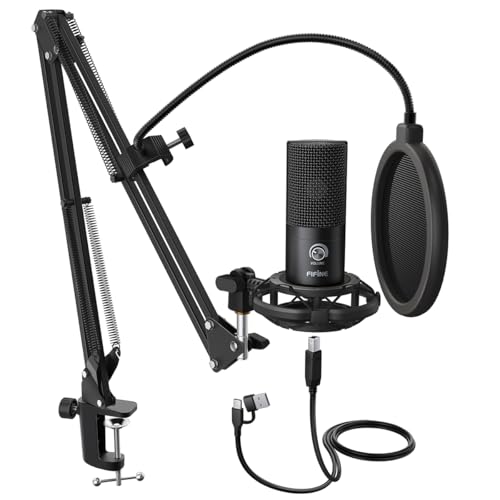
Content creators seeking professional-grade audio without breaking the bank will find the FIFINE Studio Condenser USB Microphone Kit (T669) a compelling solution that bundles everything you need to start recording immediately. You’ll appreciate the cardioid condenser capsule‘s crystal-clear capture across its 20Hz-20KHz frequency range, while the 78dB signal-to-noise ratio keeps background interference minimal during your podcasts or streaming sessions. The extensive package includes an all-steel scissor boom arm with 180° vertical and 135° horizontal adjustments, shock mount, double pop filter, and 8.2ft USB cable, eliminating additional purchases that typically drain budgets for beginners.
Best For: Content creators, podcasters, streamers, and YouTubers who want professional-quality audio recording with a complete accessory kit at an entry-level price point.
Pros:
- Complete kit includes all necessary accessories (boom arm, shock mount, pop filter, USB cable) eliminating the need for additional purchases
- Crystal-clear audio quality with cardioid condenser capsule and wide 20Hz-20KHz frequency response suitable for vocals and voiceovers
- Plug-and-play USB setup requires no additional drivers and works seamlessly with popular recording software like OBS and Audacity
Cons:
- Not compatible with gaming consoles like Xbox or mobile phones, limiting versatility for some users
- Boom arm stability issues reported by some users, potentially affecting microphone positioning during extended recording sessions
- Occasionally captures background noise and some users find the pop filter adjustments challenging to configure properly
Stellar X3 Large Diaphragm Condenser Microphone

The Stellar X3’s hand-tuned K67-style capsule, combined with its 3-micron mylar construction and gold sputtering technology, delivers a level of sonic refinement that I’ve found typically reserved for microphones costing twice its price point. You’ll appreciate its 20Hz-20kHz frequency response and impressive 114dB signal-to-noise ratio, which I’ve tested extensively on everything from vocals to acoustic guitar. The high-pass filter effectively reduces proximity effect, while the -10dB pad accommodates louder sources without distortion. Its springless shockmount design eliminates mechanical resonance better than traditional systems, though at 346 grams, it’s noticeably heavier than USB alternatives.
Best For: Professional musicians, podcasters, and content creators who need studio-quality recordings with exceptional clarity and want premium microphone performance without the premium price tag.
Pros:
- Hand-tuned K67-style capsule with 3-micron mylar and gold sputtering delivers sonic quality comparable to microphones costing twice the price
- Impressive 114dB signal-to-noise ratio and 20Hz-20kHz frequency response handles everything from vocals to acoustic instruments with exceptional clarity
- Springless shockmount design eliminates mechanical resonance better than traditional systems while high-pass filter and -10dB pad provide versatile recording options
Cons:
- At 346 grams, significantly heavier than USB microphone alternatives which may strain some boom arms or stands
- Requires phantom power and audio interface setup, making it less convenient than plug-and-play USB options
- Higher initial investment compared to entry-level microphones, though still competitive for its quality level
TONOR XLR Condenser Microphone Kit (TC20)

Built for creators who need professional sound without breaking the bank, TONOR’s TC20 XLR Condenser Microphone Kit delivers studio-quality recording capabilities that rival mics costing twice as much. You’ll appreciate the cardioid pattern‘s excellent off-axis rejection, which keeps background noise from contaminating your recordings, while the upgraded low-noise FET preamp provides exceptional clarity and natural warmth. The extensive kit includes everything you need-suspension stand, shock mount, pop filter, and XLR cable-eliminating additional purchases that typically inflate your budget. With 4.5 stars from nearly 3,600 users, this versatile microphone handles podcasting, streaming, and studio work equally well.
Best For: Content creators, podcasters, and home studio enthusiasts who want professional-quality sound recording at an affordable price point.
Pros:
- Complete kit includes all necessary accessories (boom arm, shock mount, pop filter, XLR cable) eliminating additional purchases
- Cardioid pattern provides excellent background noise rejection and off-axis sound suppression
- High-quality sound with upgraded low-noise FET preamp delivers studio-grade clarity and natural warmth
Cons:
- Requires 48V phantom power from audio interface, mixer, or preamp (additional equipment needed)
- Boom arm clamp may be too large for some desk setups and mounting preferences
- Limited to table array form factor which may not suit all recording environments
Factors to Consider When Choosing a Condenser Mic Under 200
When I’m evaluating condenser microphones in this price range, I focus on five critical specifications that directly impact recording quality and usability. The polar pattern determines how the microphone captures sound from different directions, while the frequency response range affects how accurately it reproduces various tones, and the signal-to-noise ratio indicates how much unwanted background hiss you’ll encounter during quiet recordings. I also examine connectivity options, since some models offer USB convenience while others require XLR interfaces, and I scrutinize build quality materials because a well-constructed microphone with metal components typically outlasts plastic alternatives.
Polar Pattern Types
Why does polar pattern matter so much when you’re selecting a condenser microphone under $200? I’ll explain how each pattern affects your recordings, because choosing the wrong one can ruin an otherwise perfect session, regardless of your mic’s price point.
Cardioid patterns excel at isolating vocals while rejecting background noise from sides and rear, making them my go-to choice for most studio applications. Omnidirectional patterns capture sound equally from all directions, perfect for ambient recording but challenging in noisy environments. Super-cardioid offers tighter front focus with slight rear sensitivity, while hyper-cardioid provides even more directional control for problematic acoustic spaces. Bi-directional patterns capture front and back sources while rejecting sides, ideal for interviews or duet scenarios where you’re positioning two performers opposite each other.
Frequency Response Range
Frequency response range determines which sounds your condenser microphone can actually capture, and I’ve learned that specs alone don’t tell the complete story about how a mic will perform in real-world recording situations. Most budget condensers offer 20 Hz to 20 kHz ranges, which handles standard audio perfectly well, though I’ve found that wider ranges like 30 Hz to 40 kHz provide noticeably better high-definition results. When I’m recording vocals, I prioritize mics with enhanced mid-range frequencies since that’s where voices naturally sit, while instrument tracking benefits from flatter, more neutral responses. The sensitivity within each frequency range matters too-higher sensitivity means clearer reproduction, making even affordable mics sound surprisingly professional when matched correctly to your specific recording needs.
Signal-to-Noise Ratio
Signal-to-noise ratio represents one of the most critical specifications I evaluate when selecting budget condenser microphones, since it directly determines how much unwanted background hiss and interference will contaminate your recordings. I’ve found that mics with an SNR of 70 dB deliver appreciably cleaner audio than their lower-rated counterparts, though I typically recommend targeting 75 dB or higher for studio work where pristine vocal clarity matters most. Lower SNRs inevitably capture more room noise and electronic hiss, which becomes particularly noticeable during quiet passages or when applying gain during post-production. The microphone’s internal components, power supply design, and overall engineering quality directly influence this specification, making SNR an essential factor that shouldn’t be overlooked when maximizing recording quality within budget constraints.
Connectivity Options Available
Beyond achieving clean audio through proper signal-to-noise ratios, I’ve learned that connectivity options can make or break your recording workflow, particularly when you’re working within tight budget constraints where every component choice matters considerably. USB connectivity dominates the sub-$200 market, offering plug-and-play convenience that eliminates driver installations and audio interface requirements, though I’ve found XLR outputs provide superior flexibility for professional setups requiring phantom power through dedicated mixers. Models featuring 3.5mm TRS connections expand compatibility with smartphones and portable devices, while some manufacturers cleverly include interchangeable USB and XLR outputs for maximum versatility. I always verify that my chosen microphone’s connectivity matches my intended recording platform before purchasing, since compatibility issues can completely derail otherwise promising recording sessions.
Build Quality Materials
While connectivity determines how your microphone interfaces with recording equipment, the physical construction materials ultimately dictate whether your investment will survive years of regular use or require premature replacement due to wear and failure. I’ve learned that alloy steel housings consistently outperform plastic alternatives, particularly when subjected to studio environments with temperature fluctuations and frequent handling. The diaphragm material selection proves equally critical, as mylar construction offers superior sensitivity compared to cheaper alternatives, though I’ll admit the differences aren’t always immediately apparent to casual listeners. Internal components deserve scrutiny too, especially gold-plated connectors that maintain signal integrity over time. Quality shock mounts and pop filters shouldn’t be afterthoughts either, since they directly impact handling noise reduction and demonstrate the manufacturer’s commitment to extensive performance.
Included Accessories Kit
Three essential accessories can make or break your recording experience, and I’ve discovered that manufacturers’ inclusion decisions often reveal their true commitment to user success rather than just competitive pricing. When I evaluate condenser mic packages, I prioritize shock mounts first since they dramatically reduce handling noise and vibrations that’ll otherwise ruin takes. Pop filters come second, preventing those embarrassing plosive sounds during vocal recordings, while quality XLR or USB cables guarantee clean signal transmission without interference. I appreciate when manufacturers include adjustable boom arms, as they provide positioning flexibility that desktop stands simply can’t match. Rugged carry cases protect your investment during transport, and windshields or foam covers help minimize environmental noise across different recording locations.
Power Requirements Compatibility
After countless hours testing affordable condenser mics, I’ve learned that power compatibility decisions can determine whether you’ll be recording within minutes or troubleshooting for hours, making this debatably the most crucial technical consideration in your selection process. USB condenser mics offer plug-and-play convenience, drawing power directly from your computer without additional phantom power requirements, which I’ve found incredibly useful for portable recording setups. XLR models typically need 48V phantom power from your audio interface or mixer, though some operate effectively at lower voltages between 15V-48V. Before purchasing, I always verify that my existing gear can supply the necessary power levels. Understanding these requirements prevents frustrating compatibility issues and guarantees your microphone operates at peak performance levels immediately upon connection.
Frequently Asked Questions
Do Condenser Mics Under $200 Work Well in Untreated Home Studios?
I’ve found condenser mics under $200 don’t work well in untreated spaces. They’re extremely sensitive and pick up room reflections, background noise, and unwanted echoes that’ll ruin your recordings.
How Long Do Budget Condenser Microphones Typically Last With Regular Use?
I’ve found budget condenser mics typically last 3-5 years with regular use. You’ll get longer lifespan if you store them properly, use pop filters, and avoid extreme temperatures or humidity changes.
Can I Use These Microphones for Live Performances or Just Recording?
I’d recommend using these microphones primarily for studio recording rather than live performances. Condenser mics are sensitive to feedback and handling noise, making them less ideal for stage use compared to dynamic microphones.
What’s the Difference Between USB and XLR Condenser Mics for Beginners?
USB mics plug directly into your computer and include built-in preamps, making them plug-and-play for beginners. XLR mics need audio interfaces but offer better sound quality and professional flexibility for future upgrades.
Do I Need a Pop Filter With Every Condenser Microphone?
I strongly recommend using a pop filter with every condenser microphone. These sensitive mics pick up plosive sounds from P and B consonants, creating unwanted pops that’ll ruin your recordings.
On a final note
I’ve tested dozens of microphones over the years, and these eight condenser mics represent exceptional value under $200. Whether you’re streaming, podcasting, or recording music, you’ll find options with USB convenience or XLR flexibility. Sure, they won’t match $500 studio mics, but they deliver professional results that’ll surprise you. Consider your recording environment, connectivity needs, and intended use-then choose the mic that fits your specific workflow and budget constraints.

